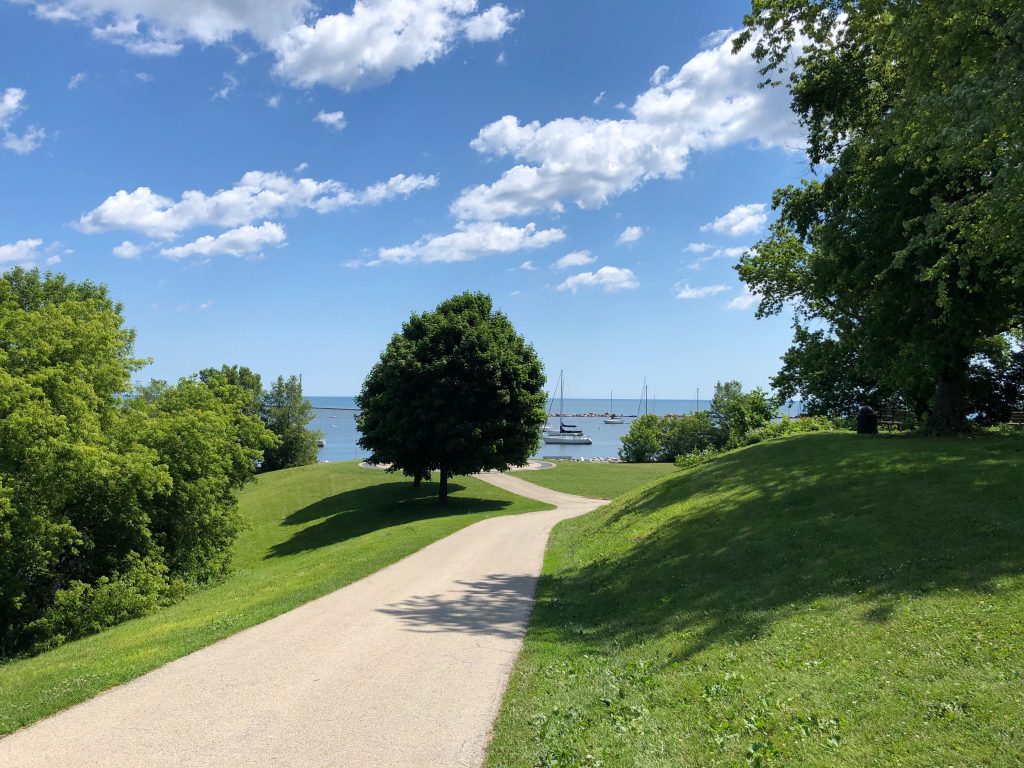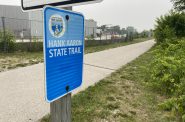Parks for People or Pavement?
Parks department wants to reduce the paved footprint in Milwaukee County.

Oak Leaf Trail. Photo by Dave Reid.
Even as Milwaukee County Parks has made it a goal to reduce the amount of pavement in the system, it struggled to meet its goals in 2022.
There are approximately 611 acres of paved surface throughout the system. Some of these paved surfaces Parks views as more critical to its mission, like bike trails and basketball courts, than others, like roadways and parking lots. The department set a goal of reducing approximately 10,000 square feet of paved surface, or roughly a quarter of an acre, in 2022.
The department wants to pursue pavement reduction for a number of reasons, beyond freeing up more parkland for greenspace. In some instances, conversions of roadways to trails lead to long-term savings on maintenance and provide infrastructure for healthy activities, like bicycling. In other cases, reducing the paved footprint can contribute to a better local environment by reducing pollution from stormwater runoff and the urban heat island effect.
The department, instead, increased paved areas by nearly 3 acres in 2022. Not all of this was bad pavement, though as Jim Tarantino, deputy director for parks, told the County Board committee focused on strategic planning on Wednesday. He note that approximately 1.6 acres of pavement were added to Brown Deer Park for a new, separated 10-foot-wide bike trail that runs for approximately 1.7 miles alongside the parkway.
“It encourages bike usage, it encourages running and walking, it improves safety for pedestrians separated from car traffic, and it’s just an improved amenity that’s going to encourage more people to live healthy lifestyles in Brown Deer Park,” Tarantino said.
Another project, reconstructing the roadway in the Root River Parkway also added some new off-street trail, but it also “effectively doubled the size of the parking lot at the Whitnall Park Beer Garden.”
Roadway and parking lot reconstruction are also incredibly expensive endeavors for a parks system that has limited resources and spends nearly all of its money on maintaining existing infrastructure, leaving limited funding for reinvestment or new amenities. “Over half of our capital requests are for parking lots and roads. And this is not something that really, really impacts recreation or health outcomes for our citizens,” Tarantino told the board’s Committee on Health Equity, Human Needs and Strategic Planning.
Tarantino pointed to parking lot projects at the McKinley Marina and the North Point lot on the southern end of Bradford Beach, which together cost nearly $11 million. “They are absolutely needed because they’re assets that are completely degraded,” he said, “but imagine eight or nine million invested in recreational assets and community centers and programming and how much more impactful that could be on achieving our vision.”
Tarantino said that the department needs to better define what pavement is good for the parks system and what pavement, in the long run, it’s trying to reduce. He suggested a pavement offset program, similar in concept to a carbon offset. If the department adds pavement to expand the Oak Leaf Trail network, it should also identify pavement elsewhere to remove.
“We’re trying to build out a future park system for people, not only for cars. We’re trying to prioritize our investment away from paved assets.”
Sup. Shawn Rolland told Tarantino that the department should identify what it can do on its own and what it needs the board to get behind to meet these pavement goals. He noted that in order to remove pavement, parks will need funding and therefore will need the county board to buy into the larger pavement removal policy itself.
And Parks has not always experienced support for pavement reduction projects. The department faced opposition from elected officials who balked at the multi-million upfront cost to convert a roadway to a trail, though such a conversion has the potential to create long-term savings as trails are less expensive to maintain. In another instance, local neighbors have railed against plans to convert a section of Jackson Park Drive into trail.
“Pavement reduction will require more difficult conversations over reducing road widths and reducing lanes of miles for automobile traffic,” Tarantino said.
MKE County
-
RNC Will Cause Some County Services To Be Moved to Wauwatosa
 Jul 12th, 2024 by Graham Kilmer
Jul 12th, 2024 by Graham Kilmer
-
Hank Aaron State Trail Will Be Closed For RNC, State Fair
 Jul 12th, 2024 by Graham Kilmer
Jul 12th, 2024 by Graham Kilmer
-
MCTS Designing New Bus Shelters
 Jul 10th, 2024 by Graham Kilmer
Jul 10th, 2024 by Graham Kilmer






















Re: the value of parking lots at North Point and McKinley Beach & Marina, these facilities are used by countless people for recreation and respite, year-round. Even in winter, people rely on access to Lake Michigan and its cooler temperatures and amenities. There is no mass transit that goes to the lakefront. Thus, functional parking lots (and street parking) are absolutely essential to creating equitable access for all people.
Minimizing pavement can have value, but not at the expense of people. During Milwaukee’s hotter-than-ever summers, especially in the main heat-island areas (with insufficient tree canopy), the lakefront can be up to 10 degrees cooler. So unless serious effort goes into mass transportation, Lakefront parking helps to serve public health in Milwaukee County.
This recent study finds that many urban areas in Milwaukee indeed are getting hotter: https://www.milwaukeeindependent.com/syndicated/heat-mapping-finds-milwaukee-experiences-hotter-summer-nights-densely-developed-urban-areas/
If parks are for people why are ducks allowed to have free access creating an environmental hazard. ? McGovern park and Washington park are becoming unusable due to the duck dropping in the grass and on the pavements
The grass is great but not for biking. I want to know why 15 years of the Botanic Gardens being free from 6 to sunset was changed to an ugly fence around the gardens, a fee, and closed at 7. That’s nuts. It’s not even close to dark then. Before covid, I was seeing so many new people, usually minorities, enjoying the gardens at night. And a big ugly metal fence is so wrong for botanic gardens. This policy needs to be looked at.
Reducing pavement can also make parks less accessible for people with mobility disabilities.
@BriPet – excellent point!~ They are often forgotten. They deserve as much access as possible.
Re: ducks and geese, parks are for people but not solely for people. They are “novel ecosystems” that are constantly in flux. Many geese often flock near the lakefront. Managing fauna in public parks is a delicate balance.
It is a delicate balance but ducks geese do not pay property taxes . Therefore they do not get a vote .Allowing ducks to have free rein in a public park is equivalent to dog s running loose. erect enclosed area with access to lagoon for the ducks and allow humans access to green space.
Keewaysservices: What do you advocate to keep all those ducks and geese in “enclosed areas”? Clipping their wings so they could not scale the borders?
And how do you feel about sharing our world with other non-taxpaying species?
Guys, the birds migrate. I can’t tell if this is satire or if folks really are that clueless.